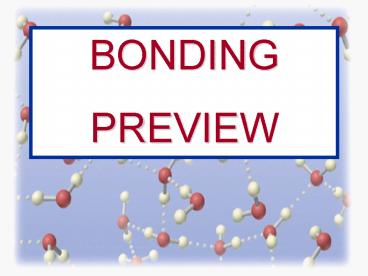BONDING - PowerPoint PPT Presentation
1 / 20
Title:
BONDING
Description:
Slide 1 ... bonding preview – PowerPoint PPT presentation
Number of Views:129
Avg rating:3.0/5.0
Title: BONDING
1
BONDING PREVIEW
2
Bonds Between Atoms
Polyatomic Ions
Ionic
Covalent
Metallic
Network Solids
Molecular Substance
Polar
Coordinate Covalent
Nonpolar
What are we going to learn about???
3
The following words will be used most lessons
- Anion- negative ion
- Cation-positive ion
- Octet Rule- rule that states that atoms tend to
gain, lose, or share electrons so that each atom
has full outermost energy level which is
typically 8 electrons. - Polyatomic Ion- charged group of covalently bound
atoms - Monatomic Ion- ion formed from a single atom
- Molecule-neutral group of atoms united by
covalent bonds - Valence electrons- an atoms outer most electrons.
- Unshared Pair- pair of electrons that is not
involved in bonding but instead is held
exclusively by one atom.
4
Marriage
Forming of a bond is like marriage
The breaking of a bond relates to a divorce.
- More stable
- exothermic
Divorce
- Less stable
- Endothermic
5
Ionic Bonds
- What is an Ionic Bond?
- An Ionic Bond is a chemical bond resulting from
the TRANSFER of electrons from one bonding atom
to another
- When is an ionic bond formed?
- An ionic bond is formed when a cation (positive
ion) transfers electrons to an anion (negative
ion).
6
What are some characteristics of an ionic bond?
- Crystalline at room temperatures
- Have higher melting points and boiling points
compared to covalent compounds - Conduct electrical current in molten or solution
state but not in the solid state - Soluble in H2O
- Strong electrostatic attractive forces between
ions
7
Covalent Bonds
- What is a Covalent Bond?
- A covalent bond is a chemical bond resulting
from SHARING of electrons between 2 bonding
atoms.
- What forms a covalent bond?
- A covalent bond is formed between two
nonmetals.
8
What are some characteristics of a covalent bond?
- Covalent bonds have definite and predicable
shapes. - Low melting solides, Liquids or Gases at normal
temperatures. - Bonds stretch, bend, rotate
- Low melting and boiling points
- Not usually soluble in water
- Not electrically conductive
9
Lewis Dot Structures
- Lewis dot structures are a shorthand to represent
the valence electrons of an atom. - The structures are written as the element symbol
surrounded by dots that represent the valence
electrons. - The Lewis structures for the elements in the
first two periods of the periodic table are shown
below.
1 2 13 14 15
16 17 18 H? He
? ? ? ? ?
? ? ? ? ?
? Li? Be? ? B ? ? C ? ? N ?
? O ? F ? Ne
?
? ? ? ? ?
? ?
10
Covalent Bonds can have multiple bonds, so you
should be familiar with the following
Single Covalent Bond- chemical bond resulting
from sharing of an electron pair between two
atoms.
Double Covalent Bond- chemical bond resulting
from sharing of two electron pairs between two
atoms.
Triple Covalent Bond-chemical bond resulting from
sharing of three electron pairs between two
atoms.
11
There are five different categories associated
with covalent bonds. What are the 5 different
categories?
Covalent
Network Solids
Molecular Substance
Polar
Coordinate Covalent
Nonpolar
12
First, we are going to look at Polar Covalent
c
What is polar covalent?
-Polar covalent is a description of a bond that
has an uneven distribution of charge due to an
unequal sharing of bonding electrons.
The boy is not equally sharing with anyone else
but rather taking all the food for himself.
13
Next, we are going to look at Non-Polar Covalent
What is non-polar covalent?
-Non polar covalent is a covalent bond that has
an even distribution of charge due to an equal
sharing of bonding electrons.
This couple is non- polar because they are
sharing the drink equally between them.
14
Next, we are going to look at Coordinate Covalent
What is a Coordinate Covalent Bond?
-A coordinate covalent bond is a bond formed
when one atom donates both electrons that are
shared.
People donate their blood to help others just
like atoms donate electrons to form stable
octets.
15
Now, we are going to look at Network Solids
What is a Network Solid?
-A network solid is a solid that has covalently
bonded atoms linked in one big network or one big
macromolecule.
Common examples of network solids include diamond
and graphite.
Characteristics of a Network Solid.
- Poor conductors of heat and electricity
- Hard / Strong
- High melting and boiling points (3D- covalent
networks)
16
Next, we are going to look at Molecular
Substances
What is a molecular substance?
-A molecular substance is a substance that has
atoms held together by covalent bonds. -The
molecules are held together by intermolecular
forces (forces among molecules) -I2, H2O,
Polymers (high low density)
17
Metallic Bonding
Name 4 Characteristics of a Metallic Bond.
What is a Metallic Bond?
- A metallic bond occurs in metals. A metal
consists of positive ions surrounded by a sea
of mobile electrons.
- Good conductors of heat and electricity
- Great strength
- Malleable and Ductile
- Luster
This shows what a metallic bond might look like.
18
Polyatomic Bonds
Polyatomic ions usually have a charge because the
collection of atoms has either gained an extra
electron or else it has lost an electron.
What is a Polyatomic Bond?
- A polyatomic bond is charged group of
covalently bonded atoms. It is made up of more
than one atom.
19
Notice all the different types of shapes that the
atoms can take on because of their bonding
Linear
Trigonal Planer
Trigonal Bipyramidal
Tetrahedral
Octahedral
20
Just as a summary to what each bond looks like































